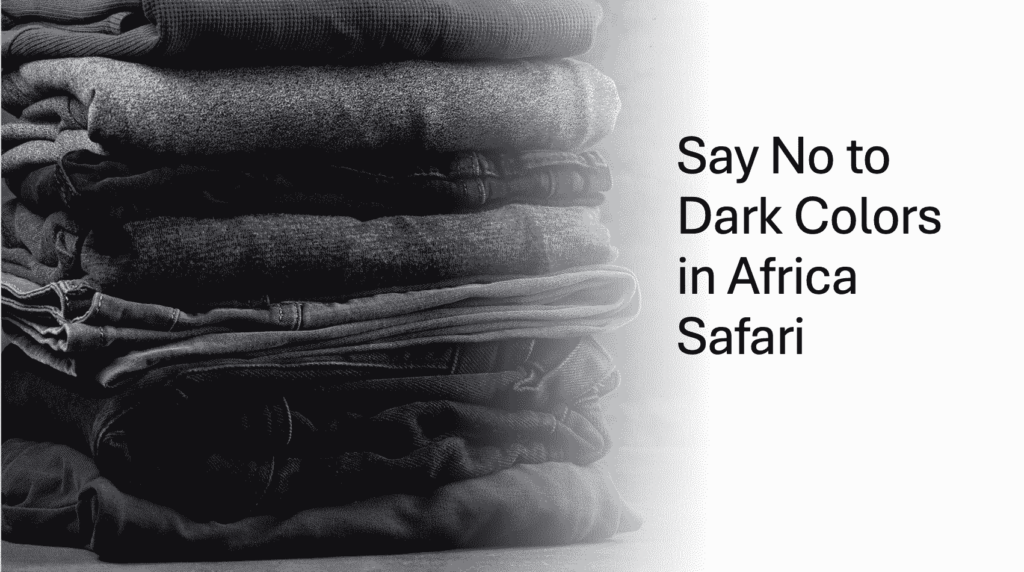
Are you preparing to visit a safari in South Africa, Kenya, or another Safari destination like Tanzania and you are unsure as to what to wear and not to wear there? We understand that one of the most important aspects of your preparation is understanding Safari clothing tips to ensure your adventure is both safe and enjoyable. Therefore, we have put together this blog post to address this concern and to significantly enhance your safari experience.
First, it is important to understand wildlife viewing is possible without anything to worry about. There are numerous African game reserves, national parks, and wildlife viewing destinations interested travelers can visit. These resources are in place for healthy public viewing, education, and reservation purposes. Some of these locations are well-kept and protected to enable restrained engagement with the wild creatures safely and honourably.
So, we can liken a Safari treat to a safe escapade of untamed wildlife that is subjected to certain laws and regulations. This means what can disrupt such an environment is ignoring the rules of wildlife living and mingling.
Safari Clothing Principles or Mistakes
A guiding principle that shouldn’t be ignored is the right dress sense for a Safari, especially as following the correct Safari clothing tips is tantamount to safeguarding a memorable adventure with wild creatures.
When Safari attire do’s and don’ts are misunderstood or ignored, it can result in significant losses for a traveling group or safari parties. As the interest develops to come to view wildlife, the first thing to bear in mind is what should you not wear on an African Safari. This aids in planning and packing for a Safari.
In light of these attire considerations, is there possibly a dress code for an African Safari? There are major Safari clothing tips to consider. Here, we have revealed as much as you should avoid to go see the wildlife in their natural habitat.
As adventurous as one can be, dressing smart to fit the occasion is of utmost importance. And for a unique experience like coming on African Safari, you can’t beat what you should not wear to it.
Understanding the African Safari Dress Code
The breathtaking tour to visit the wildlife in South Africa, Tanzania, Kenya, and other African soils is what an African Safari entails. Each of these places has some strict guiding principles that warrant a reputable dress code to suit the environment.
Interestingly, Safari has a rule of thumb which is to dress in layers for all activities and wear shades of the African bush. This prevents unnecessary animal attraction that could cause loss or damage.
Since it’s not so much a fashion zone, the peculiar thing to do is watch and enjoy the view of the live animals co-exist in their habitat.
So when next you come on a Safari, try to avoid the prohibited safari attires to ensure your comfort and safety and achieve a well-rounded Safari experience.
RECOMMENDED: How Much is an African Safari Adventure: Cost to Consider
Avoid Bright Colors in African Safari: The Impact on Wildlife and Safety
Packing bright-coloured clothes is a Safari clothing mistake to avoid completely. This has been considered the most critical among the Safari clothing tips to avoid because bright colours like pink, orange, or red are very noticeable and spark up threat concerns amongst the creatures. On such occasions, they become uncomfortable and tend to defend themselves and harm their rivalries.
Wearing bright colours, especially during a walking safari, will attract them to move close to you. One can never tell what will occur, even if it means sitting in a Safari truck all the while.
What about wearing white for the adventure? A Safari first timer wouldn’t know but light colors necessarily shouldn’t be bright. Choose light colours that are mild. Showcasing white tops, shorts or pants ensues unnecessary attention. It’s best to leave whites behind as they accumulate dust, causing discomfort and it is potentially disturbing wildlife.
Safari clothing tips: Say No to Dark Colors in Africa Safari

Another essential Safari clothing tip is to steer clear of dark colours like black or deep blue. Wearing dark colours on a Safari is equally not advisable as bright colours. They seem to be an acceptable colour for Safari attire, yet they are not for the following reasons.
Heat Considerations
Colours such as black, deep blue, and other dark ones easily absorb heat. For tropical locations in Africa, wearing these colours causes discomfort within a short time of outdoor activities.
Insect Considerations
The zones are also insect-infested areas, particularly for mosquitoes. Dark colours attract these insects. Notably, amongst them is the colour blue, which attracts tsetse flies, which transmits the bacteria that causes sleeping sickness.
So whether you are taking your Safari event in Kenya, Tanzania, or Uganda, steer clear of dark colours. Nobody loves to encounter insect bites and their usual complications. So, it’s just advisable to avoid dark colours during the day and at night.
Skip the Camouflage: Legal and Cultural Safari Clothing Tips
While camouflage might seem like a practical choice, it’s actually one of the Safari clothing tips to avoid. In Africa, camouflage is easily associated with the military. In most African countries it’s illegal to put them on. So as a guest on a Safari, do not camouflage.
Aside from military concerns, why you should not wear camouflage on a safari is also to keep an open relationship with the locals.
Wildlife destinations employ hands, some of which are the locals. Other personalities know and work by the rules. For peaceful interactions with such attendants, it’s fine to abide by the rules to achieve seamless wilderness sightseeing.
RECOMMENDED: Is Safari Better in South Africa or Kenya?
Safari clothing tips: Avoid Tight and Revealing Clothing
What should you not wear on an African Safari is tight and revealing clothes. As much as you want to be creative with your Instagram posts and videos, here is an occasion you should focus on safety and comfort in this vacation.
Tightening garments causes exhaustion from moving briskly or joining the Safari truck when away on the field. Little or too much revealing clothes are not needed as it is unsafe. A more subtle concern is the cultural flaw it can pose in an African environment.
Safaris are opportunities to enjoy the animal world and see for yourself what they look like, but it comes with its share of dos and don’ts. Letting this stick can make a lot of difference for your next Safari voyage.
Therefore, on the next one, or the first time as the case may be, come with breathable clothes in warm and natural colors such as brown, green, and cool colours. This makes a good balance of functionality and comfortability. You can look into safari journals and follow Alice to capture the safest safari clothing tips.
Footwear: Why You Should Skip Sandals and Flip-Flops in African Safari


At any safari outing, it’s comforting to have dried feet, un-itching and un-hurting which largely depends on your footwear for the Safari escapade
According to tours and travel experts, something as unimportant as footwear can sabotage your Safari quest. If this matters, purchase quality ankle-protecting boots or sneakers, especially if your itinerary includes walking to witness the wilderness.
Avoid wearing sandals and flip-flops on a Safari trip. Such footwear accommodates crawling insects, particularly snakes and scorpions. Using sturdy shoes instead protects your feet and prevents injuries and foot accidents. You are also more confident walking in these outdoor shoes than ordinary scandals, which are inappropriate for the wild terrain.
Jewelry and Accessories: What to Leave Behind
For some of us who wouldn’t do without a bangle or neck chain, a Safari is not the best time to showcase our love for jewellery and other accessories.
Jewellery on Safari comes at the expense of loss, poor wildlife experience, and unwarranted risk for theft.
The animals should be the focus of attention at this time and not some heavy deck jewellery accomplice. Except for the usual casual jewellery, it is advisable to keep them at home. This is to guard against weariness, personal or group discomfort, and negative wildlife comportment.
Fragrance and Perfume: Why Scents are a No-Go in Safaris
Safari clothing mistakes to avoid include wearing no perfume on safari. While the fragrance is good, it’s not necessary for this kind of vacation. Animals have a strong ability to depict smell. They capture their prey through odours and have sharp sensory organs to depict different kinds of smell.
Insects, for instance, trace odours to find the source. If you appear with heavy underarm antiperspirant or body fragrance, it exposes you to these insects.
When such happens you are not only affected but the Safari parties on the go with you. Consequently, the atmosphere is disturbing and uncomfortable for both adventurists and wildlife.
RECOMMENDED: Cons and Risks of an African Safari: Things to Know
Conclusion: Safari clothing tips
The untamed wildlife cannot speak perse, but they communicate in various forms and reactions. So choosing what to wear to come visit means a lot.
Unfortunately, it’s not just about the clothes; it includes designs, patterns, fitness and comfortability, colour, texture, and other key components of the choice of clothes for a Safari.
So before journeying on a Safari, whether as a first-timer or enthusiast, carefully address the all-time issue of what should you not wear on an African Safari.
An ideal way to cut out the stress is to adhere to the guides we have compiled. There are also useful travel and Safari resources for consultation and planning. Navigate these aids to pack smart and get ready for great wildlife viewing anywhere in Africa.
Remember the best attitude that brings more fun on a Safari is dancing to the tune of the host community- the animals as well as the locals. What they frown at is what tourists should frown at, at least for the time frame and for the sake of a fulfilling Safari experience.
So, we can add to the rule of thumb that inappropriate clothing can affect wildlife viewing, comfort, and personal safety.



0 Comments